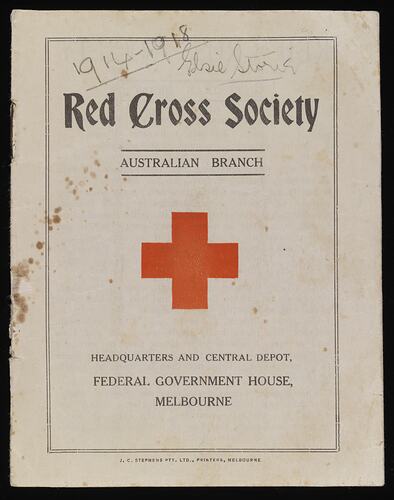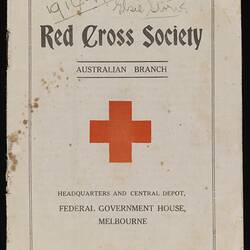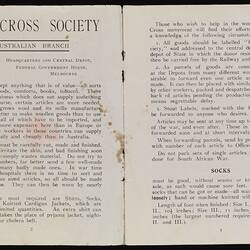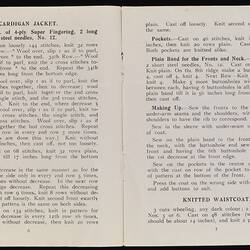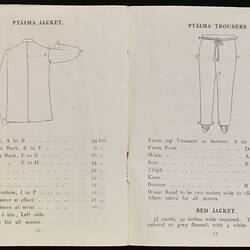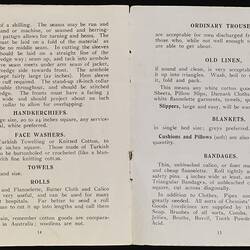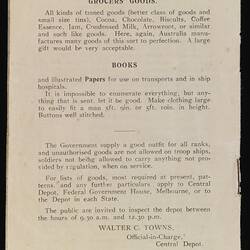Summary
Paper booklet with information about goods which were needed by the Red Cross during World War I for onward transmission to servicemen and to Army hospitals. The booklet was printed by J.C. Stephens Pty Ltd, Melbourne, around 1914.
The booklet includes advice on knitting socks, sewing clothing, making handkerchiefs, providing bandages, rolls of flannel, blankets, towels, tinned goods and books for the war effort. There are knitting patterns for socks, a cardigan jacket, a knitted waistcoat, a knitted cholera belt, a woollen helmet, mittens and mufflers, and sewing patterns for a flannel vest or undershirt, flannel underpants, a shirt, pyjama jacket, pyjama trousers and a bed jacket.
The booklet belonged to Miss Elsie Storie of Brunswick, later of Canterbury, a young woman during the War. During the World War I, Australians made thousands of socks, bandages, items of clothing and other 'comforts' for the war effort. Many were sent to soldiers at the front; others supplied convalescent hospitals in Australia. The work was largely co-ordinated by branches of the Red Cross, and this booklet provides detailed instructions to those who were involved in this part of the war effort.
Part of a larger collection of paper-based ephemera that was collected by the donor, Mr Millward, from a rubbish skip at the factory where he worked (the Nicholas Aspro Factory) on its closure several years ago. The material, contained in a box, was part of a deceased estate of Miss Elsie Storie; it may have been discarded by a director of the factory who had acted as Miss Storie's executor. As a group, the material allows us insight into aspects of the life of a middle-class Melbourne woman who was born around1895, lived through both wars, and remained in Melbourne all her life.
Physical Description
Paper booklet, 16 pages, entitled 'Red Cross Society, Australian Branch', giving information about goods which were needed by the Red Cross during World War I for onward transmission to servicemen and to Army hospitals. The booklet includes advice to those who were knitting or sewing clothing or medical aids, or acquiring tinned goods and books for the war effort. It advises that people should 'Make clothing large to easily fit a man 5'9" or 5'10" in height, buttons well stitched. . In war time and at busy hospitals there is no time to sort and pick out various sized articles, so all should be made large and loose. They can then be worn by nearly all soldiers.'
More Information
-
Collecting Areas
-
Acquisition Information
Donation from Mr John Millward, Mrs Millward, Jun 2005
-
Printer
-
Publisher
-
Inscriptions
Text, front cover: 'Red Cross Society / AUSTRALIAN BRANCH / HEADQUARTERS AND CENTRAL DEPOT, / FEDERAL GOVERNMENT HOUSE, / MELBOURNE / J.C. STEPHENS PTY. LTD. PRINTERS, MELBOURNE'.
-
Classification
Medicine & health, Health organisations, Promotional materials
-
Category
-
Discipline
-
Type of item
-
Overall Dimensions
11.7 cm (Width), 14.9 cm (Height)
-
Dimensions
113 mm (Width), 148 mm (Height)
Measurement From Conservation.
-
Keywords
Wars & Conflicts, World War I, 1914-1918, Soldiers' Comforts, Cholera
